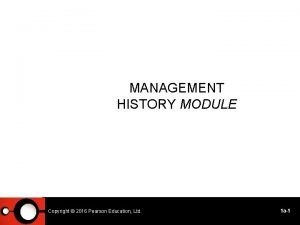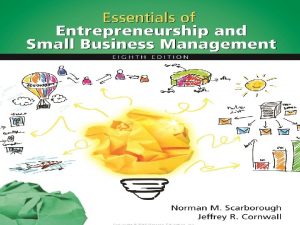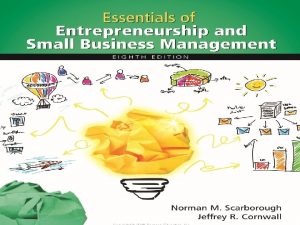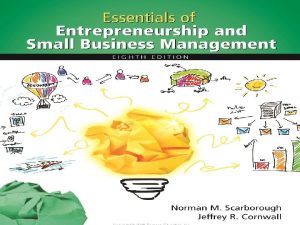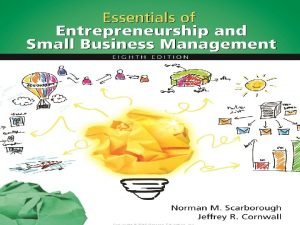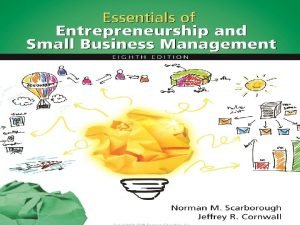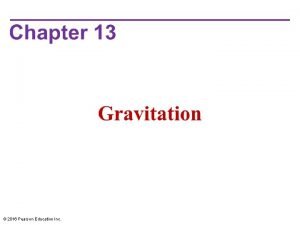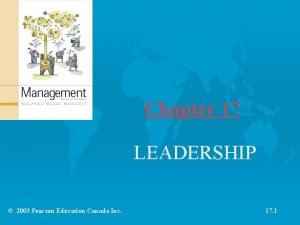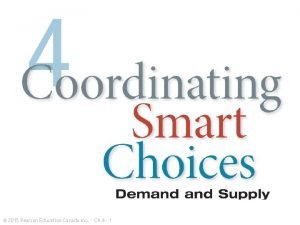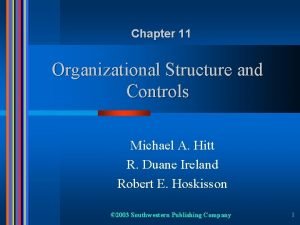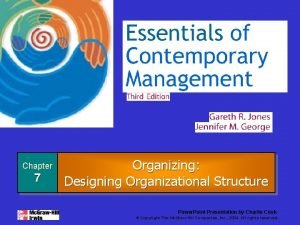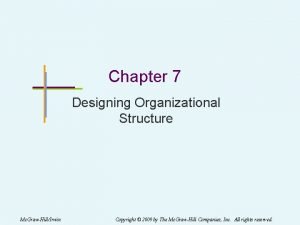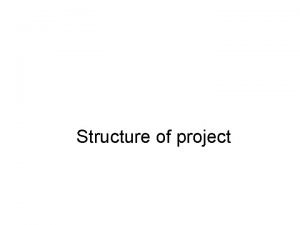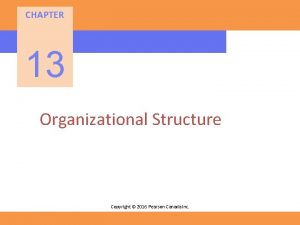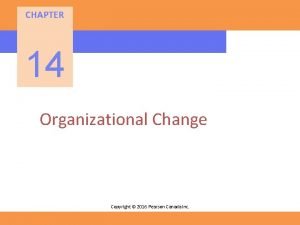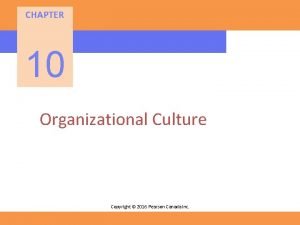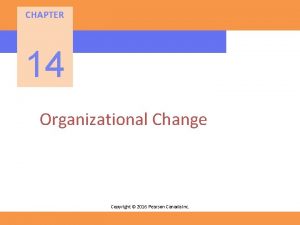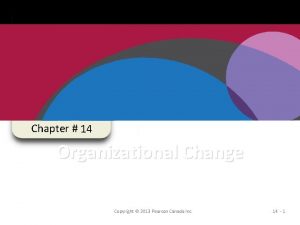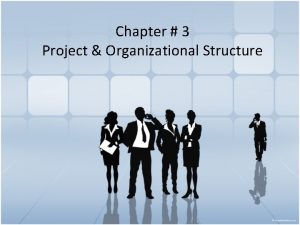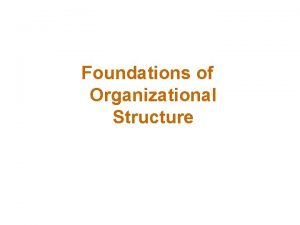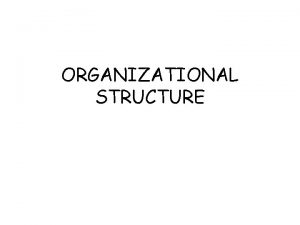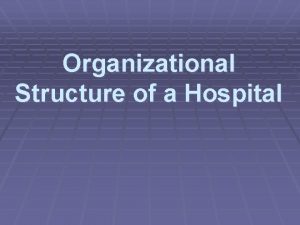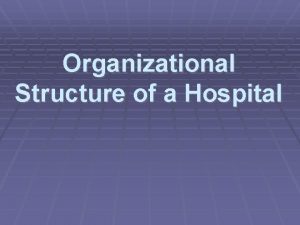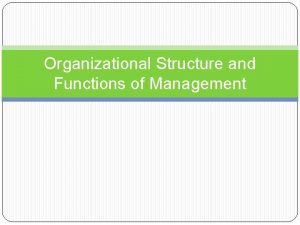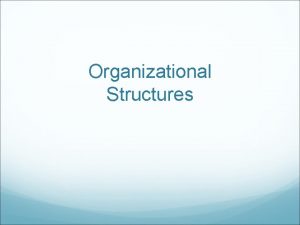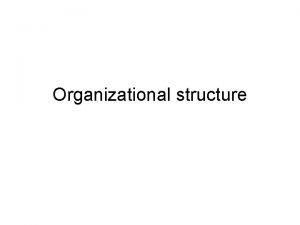CHAPTER 13 Organizational Structure Copyright 2016 Pearson Canada




















































- Slides: 52

CHAPTER 13 Organizational Structure Copyright © 2016 Pearson Canada Inc.

Chapter Outline • What Is Organizational Structure? – Work Specialization – Departmentalization – Chain of Command – Span of Control – Centralization and Decentralization – Formalization • Common Organizational Designs – The Simple Structure – The Bureaucracy – The Matrix Structure Copyright © 2016 Pearson Canada Inc.

Chapter Outline • New Design Options – The Virtual Organization – The Boundaryless Organization – The Leaner Organization: Organization Downsizing • Why Do Structures Differ? – – Strategy Organizational Size Technology Environment • Organizational Designs and Employee Behaviour Copyright © 2016 Pearson Canada Inc.

Learning Outcomes 1. Identify the six elements of an organization’s structure. 2. Describe the characteristics of a bureaucracy. 3. Describe the characteristics of a matrix organization. 4. Describe the characteristics of a virtual organization. Copyright © 2016 Pearson Canada Inc.

Learning Outcomes 5. Understand why managers would want to create a boundaryless organization. 6. Demonstrate how organizational structures differ, and contrast mechanistic and organic structural models. 7. Analyze the behavioural implications of different organizational designs. Copyright © 2016 Pearson Canada Inc.

What Is Organizational Structure? • Organizational structure defines how job tasks are formally divided, grouped, and coordinated. • Six key elements when they design their organization’s structure: – – – work specialization departmentalization chain of command span of control centralization and decentralization formalization Copyright © 2016 Pearson Canada Inc.

Exhibit 13 -1 Six Key Questions for Organizational Structure Copyright © 2016 Pearson Canada Inc.

Work Specialization • The degree to which tasks in the organization are subdivided into separate jobs. – Also known as division of labour. • Benefits: – Efficiency - less time changing tasks, putting equipment away – Easier to train employees • Downsides: – Boredom, stress, low productivity, high turnover, increased absenteeism Copyright © 2016 Pearson Canada Inc.

Departmentalization • The basis on which jobs are grouped together. • Types: – – – Functional Product Geographic Process Customer Copyright © 2016 Pearson Canada Inc.

Chain of Command • Continuous line of authority that extends from upper organizational levels to the lowest level and clarifies who reports to whom. – Authority • Who has the right to give orders and expect them to be obeyed. – Unity of command • Subordinates should have only one superior. – Delegation • Assignment of authority to another person to carry out specific duties, allowing the employee to make some of the decisions. Copyright © 2016 Pearson Canada Inc.

Span of Control • Number of subordinates that can be efficiently and effectively managed. • Small span – Expensive, more managers. – Makes vertical communication more complicated. – Encourages tight supervision and discourages autonomy. • Larger span – Empowers workers. – Speeds up decisions. Copyright © 2016 Pearson Canada Inc.

Exhibit 13 -2 Contrasting Spans of Control Copyright © 2016 Pearson Canada Inc.

Centralization and Decentralization • Centralization – The degree to which decision making is concentrated at a single point in the organization. • Decentralization – The degree to which decision making is distributed to lower level employees. • Makes it easier to address customer concerns quickly Copyright © 2016 Pearson Canada Inc.

Formalization • Degree to which jobs within the organization are standardized. • How standardized are the jobs? – High formalization means employees have little discretion. – Low formalization means employees have more freedom. Copyright © 2016 Pearson Canada Inc.

The Simple Structure • Strengths: – Simplicity: fast, flexible, inexpensive. • Weakness: – Works best in small organizations. – Can slow down decision making in larger organization. – Can be risky as it relies on one person to make all decisions. Copyright © 2016 Pearson Canada Inc.

The Family Business • Family businesses employ 6 million people in Canada and represent more than 60 percent of the gross domestic product. • Family businesses face both family/personal relations and business/management relations. • Family businesses must manage the conflicts found within families as well as the normal business issues that arise for any business. Copyright © 2016 Pearson Canada Inc.

The Bureaucracy • Strengths: – Standardizes activities in an efficient manner. • Economies of scale, minimum duplication of personnel and equipment. • Lower quality employees are acceptable, which reduces employment costs. • Weaknesses: – Creates subunit conflicts. – There is an obsessive concern with following rules. Copyright © 2016 Pearson Canada Inc.

The Matrix Structure • Breaks the unity of command principle. – Employees have two bosses. Advantages: – Facilitates coordination when there are many activities. – More communication. – Efficient allocation of specialists. • Disadvantages: – Power struggles, confusion, stress. Copyright © 2016 Pearson Canada Inc.

Exhibit 13 -4 Matrix Structure for a Faculty of Business Administration Copyright © 2016 Pearson Canada Inc.

New Design Options • Breaking the boundaries externally – Virtual Organization (also called the network organization or modular organization) • Breaking the boundaries externally and internally – Boundaryless Organization Copyright © 2016 Pearson Canada Inc.

Virtual Organization • A continually evolving network of independent companies—suppliers, customers, even competitors—linked together to share skills, costs, and access to one another’s markets. • Advantages: – Organizations can share costs and skills. – Provides access to global markets. – Increases market responsiveness. • Disadvantages: – Companies give up operational and strategic control to work together. – Managers need to be more flexible, acquire new skills. Copyright © 2016 Pearson Canada Inc.

Exhibit 13 -4 A Virtual Organization Copyright © 2016 Pearson Canada Inc.

The Boundaryless Organization • An organization that seeks to eliminate the chain of command, have limitless spans of control, and replaces departments with empowered teams. • It breaks down barriers internally by flattening the hierarchy, creating cross-hierarchical teams, and using participative decision-making practices and 360 -degree performance appraisals. Copyright © 2016 Pearson Canada Inc.

The Leaner Organization: Organization Downsizing • Downsizing – A systematic effort to make an organization leaner by selling off business units, closing locations, or reducing staff. – It has been very controversial because of its potential negative impacts on employees. • Advantages: – Huge reduction in wage costs – Can see positive effects on stock prices after the announcement • Disadvantages: – Employee attitudes, sickness absences, lower concentration on the job, and lower creativity – Can lead to more voluntary turnover Copyright © 2016 Pearson Canada Inc.

Effective Strategies for Downsizing • Investment • Communication • Participation • Assistance Copyright © 2016 Pearson Canada Inc.

Why Do Structures Differ? • Two extreme models of organizational design Mechanistic model and Organic Model – Mechanistic model • High specialization • Rigid departmentalization • Clear chain of command • Narrow spans of control • Limited information network • Centralization Copyright © 2016 Pearson Canada Inc.

Why Do Structures Differ? • Two extreme models of organizational design – Organic model • Flat • Uses cross-functional and cross-hierarchical teams • Possesses a comprehensive information network • Has wide spans of control • Has low formalization Copyright © 2016 Pearson Canada Inc.

Exhibit 13 -5 Mechanistic vs. Organic Models Copyright © 2016 Pearson Canada Inc.

Why Do Structures Differ? • Strategy • Organizational Size • Environment • Technology Copyright © 2016 Pearson Canada Inc.

Why Do Structures Differ? • Strategy – Innovation, cost minimization, and imitation. • Three Strategy Dimensions – Innovation – Cost-Minimization – Imitation Copyright © 2016 Pearson Canada Inc.

Exhibit 13 -6 The Strategy-Structure Relationship Copyright © 2016 Pearson Canada Inc.

Why Do Structures Differ? • Organizational Size – An organization’s size significantly affects its structure. – Organizations that employ 2000 or more people tend to have more specialization, more departmentalization, more vertical levels, and more rules and regulations than small organizations. – The relationship isn’t linear; rather, size affects structure at a decreasing rate. Copyright © 2016 Pearson Canada Inc.

Why Do Structures Differ? • Technology – Every organization has at least one technology for converting financial, human, and physical resources into products or services. – The common theme that differentiates technologies is their degree of routineness. • Environment – Composed of forces outside the organization and the uncertainty associated with them. Copyright © 2016 Pearson Canada Inc.

Key Dimensions of an Organization’s Environment • Capacity – Degree to which environment can support growth. • Volatility – Degree of instability in an environment. • Complexity – Degree of heterogeneity and concentration in environment. Copyright © 2016 Pearson Canada Inc.

Exhibit 13 -7 Three-Dimensional Model of the Environment Copyright © 2016 Pearson Canada Inc.

Organizational Designs and Employee Behaviour • • To maximize employee performance and satisfaction, managers must take into account individual differences, such as experience, personality, and the work task, as well as culture. People are attracted to, are selected by, and stay with organizations that suit their personal characteristics. Those who prefer predictability are likely to seek out and take employment in mechanistic structures Those who want autonomy are more likely to end up in an organic structure. Copyright © 2016 Pearson Canada Inc.

Global Implications • Culture and Organizational Structure • Culture and Employee Structure Preferences • Culture and the Boundaryless Organization • Culture and the Impact of Downsizing Copyright © 2016 Pearson Canada Inc.

Exhibit 13 -8 Organizational Structure: Its Determinants and Outcomes Copyright © 2016 Pearson Canada Inc.

Summary 1. Organizational structure determines the level of autonomy an individual has. 2. Organizational strategy, organizational size, technology, and environment determine an organization’s structure. 3. There is no one best structure, and individuals differ in their preference of organizational structure. Copyright © 2016 Pearson Canada Inc.

OB at Work: For Review 1. What are the six key elements that define an organization’s structure? 2. What are the characteristics of a bureaucracy, and how does it differ from a simple structure? 3. What are the characteristics of a matrix organization? 4. What are the characteristics of a virtual organization? Copyright © 2016 Pearson Canada Inc.

OB at Work: For Review 5. Why would managers create a boundaryless organization? 6. Why do organizational structures differ, and what is the difference between a mechanistic structure and an organic structure? 7. What are the behavioural implications of different organizational designs? Copyright © 2016 Pearson Canada Inc.

OB at Work: For Managers ■ Specialization can make operations more efficient, but remember that excessive specialization can create employee dissatisfaction and reduce motivation. ■ Avoid designing rigid hierarchies that overly limit employees’ empowerment and autonomy. ■ Balance the advantages of virtual and boundaryless organizations against the potential pitfalls before adding flexible workplace options. Copyright © 2016 Pearson Canada Inc.

OB at Work: For Managers ■ Downsize your organization to realize major cost savings, and focus the company around core competencies—but only if necessary because downsizing can have a significant negative impact on employee morale. ■ Consider the scarcity, dynamism, and complexity of the environment, and balance the organic and mechanistic elements when designing an organizational structure. Copyright © 2016 Pearson Canada Inc.

Breakout Group Exercises • Form small groups to discuss the following: 1. Describe the structure of an organization in which you worked. Was the structure appropriate for the tasks being done? 2. Have you ever worked in an organization with a structure that seemed inappropriate to the task? What would have improved the structure? 3. You are considering opening up a coffee bar with several of your friends. What kind of structure might you use? After the coffee bar becomes successful, you decide that expanding the number of branches might be a good idea. What changes to the structure might you make? Copyright © 2016 Pearson Canada Inc.

Words-in-Sentences Company • Raw materials – Letters • Product – Words • Packaging – Sentences (words go out the door in sentences rather than boxes) • Production run – All sentences created during a ten minute period. No word repeated in any sentence. Copyright © 2016 Pearson Canada Inc.

Rules to Pass Quality Control • A letter may appear only as often in a manufactured word as it appears in the raw material phrase; for example, “organizational behaviour is fun” has one L and one E. Thus “steal” is legitimate, but not “teller”. It has too many l’s and e’s. • Raw material letters can be used again in different manufactured words. • A manufactured word may be used only once during a production run; once a word (e. g. , “the”) is used in a sentence, it is out of stock for the rest of the production run. No other sentence may use the word “the”. • A new word may not be made by adding “s” to form the plural of an already used manufactured word. • Sentences must make grammatical and logical sense. • All words must be in the English language. • Names and places are acceptable. • Slang is not acceptable. • Writing must be legible. Any illegible sentence will be disqualified. • Only sentences that have a minimum of three words and a maximum of six words will be considered. Copyright © 2016 Pearson Canada Inc.

Raw Materials • Outside, the wind teased the palm fronds into rattling conspiracies. Copyright © 2016 Pearson Canada Inc.

Raw Materials • The place had bevelled windowpanes, pecan paneling and traditional furniture in mahogany. Copyright © 2016 Pearson Canada Inc.

Raw Materials • A Connecticut Yankee said “parsley, sage, rosemary and thyme. ” Copyright © 2016 Pearson Canada Inc.

Raw Materials • King Arthur’s court feared the wrath of Khan. Copyright © 2016 Pearson Canada Inc.

Learning Points • What structure did you use at first? • What structure evolved? • How did the task affect structure? Copyright © 2016 Pearson Canada Inc.

Concepts to Skills: Delegating Authority • Clarify the assignment. • Specify the employee’s range of discretion. • Allow the employee to participate. • Inform others that delegation has occurred. • Establish feedback controls. Copyright © 2016 Pearson Canada Inc.
 Pearson education inc 4
Pearson education inc 4 2016 pearson education inc
2016 pearson education inc 2016 pearson education inc
2016 pearson education inc Pearson education inc 1
Pearson education inc 1 2016 pearson education inc
2016 pearson education inc 2016 pearson education inc
2016 pearson education inc 2016 pearson education inc
2016 pearson education inc 2016 pearson education inc
2016 pearson education inc 2016 pearson education inc
2016 pearson education inc 2016 pearson education inc
2016 pearson education inc 2016 pearson education inc
2016 pearson education inc 2016 pearson education inc
2016 pearson education inc 2016 pearson education inc
2016 pearson education inc 2016 pearson education inc
2016 pearson education inc Pearson education limited 2017
Pearson education limited 2017 2017 pearson education inc
2017 pearson education inc 2010 pearson education inc
2010 pearson education inc Copyright 2009
Copyright 2009 2018 pearson education inc
2018 pearson education inc Copyright 2014 pearson education inc
Copyright 2014 pearson education inc Copyright 2010 pearson education inc
Copyright 2010 pearson education inc Copyright 2010 pearson education inc
Copyright 2010 pearson education inc Copyright by pearson education inc. answers
Copyright by pearson education inc. answers Copyright 2003 pearson education inc
Copyright 2003 pearson education inc Copyright 2005 pearson prentice hall inc
Copyright 2005 pearson prentice hall inc Copyright 2009 pearson education inc
Copyright 2009 pearson education inc Copyright pearson education inc
Copyright pearson education inc Copyright 2010 pearson education inc
Copyright 2010 pearson education inc Copyright 2010 pearson education inc
Copyright 2010 pearson education inc Copyright 2010 pearson education inc
Copyright 2010 pearson education inc Copyright 2010 pearson education inc
Copyright 2010 pearson education inc Copyright 2010 pearson education inc
Copyright 2010 pearson education inc Copyright 2010 pearson education inc
Copyright 2010 pearson education inc Copyright 2010 pearson education inc
Copyright 2010 pearson education inc Copyright 2009 pearson education inc
Copyright 2009 pearson education inc Copyright 2009 pearson education inc
Copyright 2009 pearson education inc Copyright 2009 pearson education inc
Copyright 2009 pearson education inc 2009 pearson education inc
2009 pearson education inc Copyright pearson education inc
Copyright pearson education inc Pearson publishing canada
Pearson publishing canada Pearson publishing canada
Pearson publishing canada Pearson canada inc.
Pearson canada inc. 2011 pearson education
2011 pearson education 2011 pearson education inc
2011 pearson education inc Pearson vue president
Pearson vue president Educational pearson pearson times
Educational pearson pearson times Pearson education inc publishing as pearson prentice hall
Pearson education inc publishing as pearson prentice hall Pearson education inc. 2012
Pearson education inc. 2012 2008 pearson prentice hall inc
2008 pearson prentice hall inc Sbu m-form structure
Sbu m-form structure Chapter 7 designing organizational structure
Chapter 7 designing organizational structure Chapter 7 designing organizational structure
Chapter 7 designing organizational structure Pure project organizational structure template
Pure project organizational structure template


